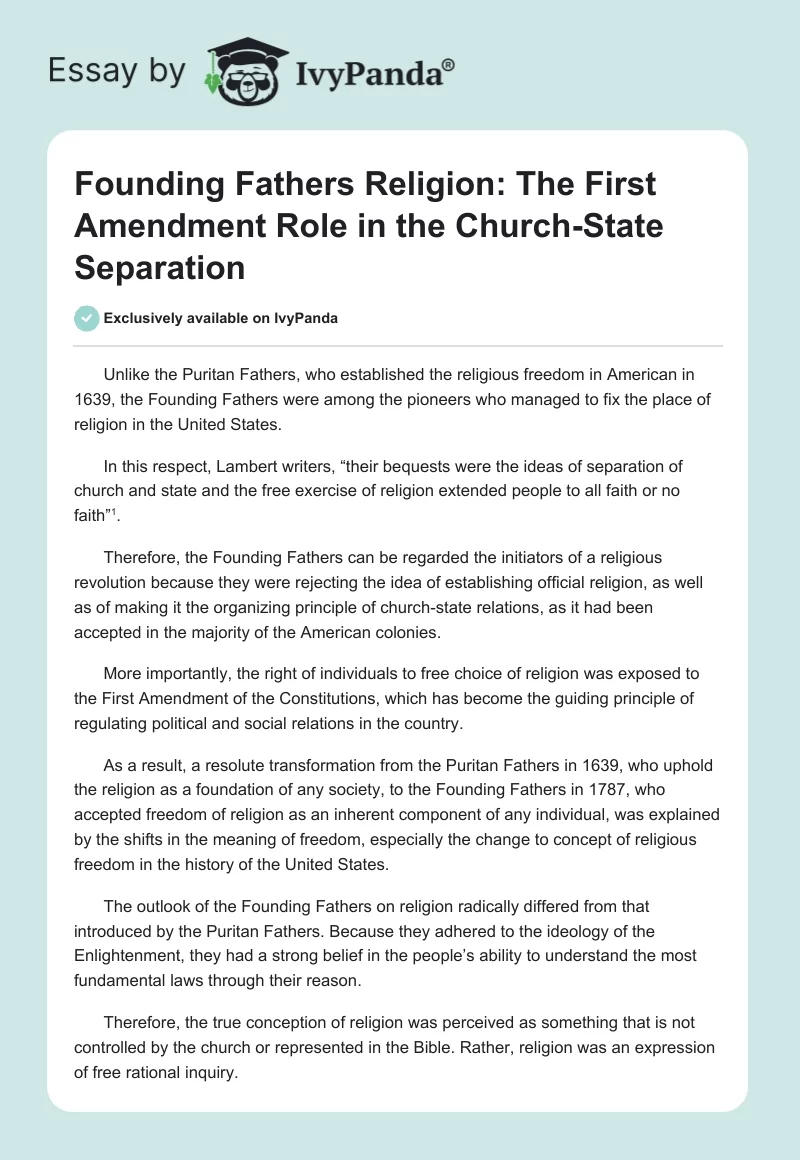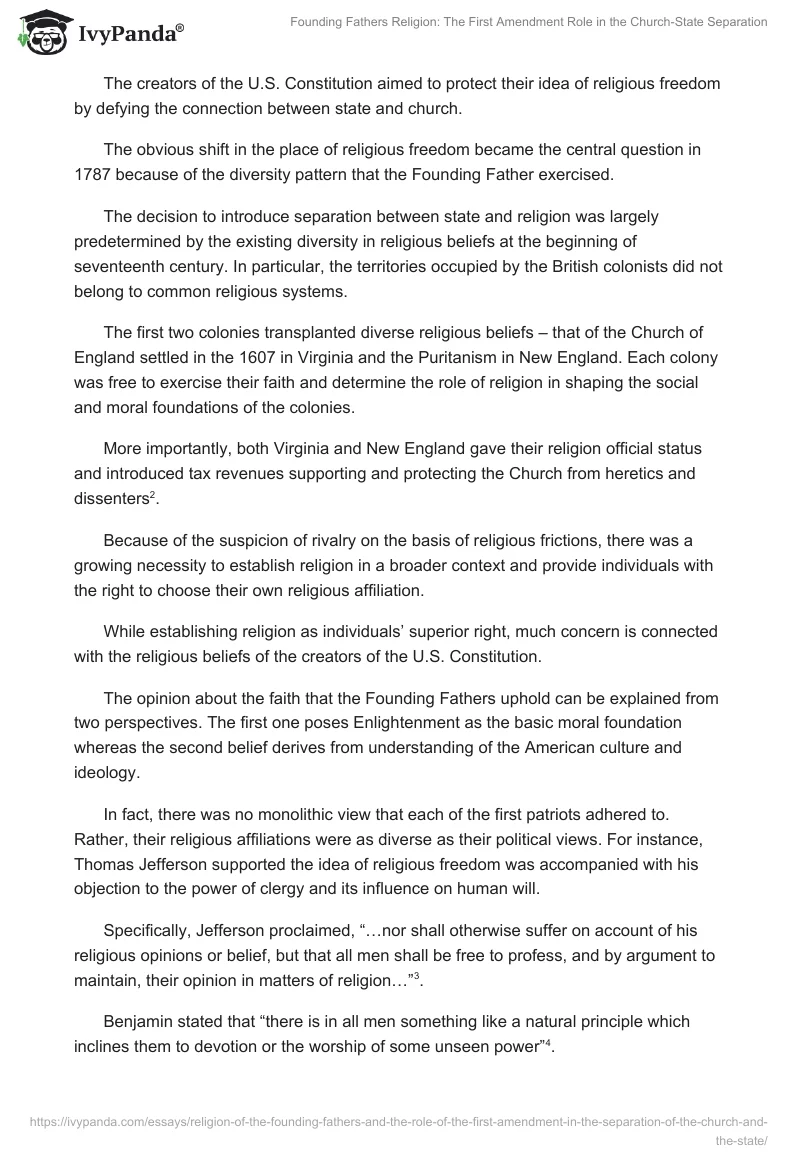Unlike the Puritan Fathers, who established the religious freedom in American in 1639, the Founding Fathers were among the pioneers who managed to fix the place of religion in the United States.
In this respect, Lambert writers, “their bequests were the ideas of separation of church and state and the free exercise of religion extended people to all faith or no faith”.
Therefore, the Founding Fathers can be regarded the initiators of a religious revolution because they were rejecting the idea of establishing official religion, as well as of making it the organizing principle of church-state relations, as it had been accepted in the majority of the American colonies.
More importantly, the right of individuals to free choice of religion was exposed to the First Amendment of the Constitutions, which has become the guiding principle of regulating political and social relations in the country.
As a result, a resolute transformation from the Puritan Fathers in 1639, who uphold the religion as a foundation of any society, to the Founding Fathers in 1787, who accepted freedom of religion as an inherent component of any individual, was explained by the shifts in the meaning of freedom, especially the change to concept of religious freedom in the history of the United States.
The outlook of the Founding Fathers on religion radically differed from that introduced by the Puritan Fathers. Because they adhered to the ideology of the Enlightenment, they had a strong belief in the people’s ability to understand the most fundamental laws through their reason.
Therefore, the true conception of religion was perceived as something that is not controlled by the church or represented in the Bible. Rather, religion was an expression of free rational inquiry.
The creators of the U.S. Constitution aimed to protect their idea of religious freedom by defying the connection between state and church.
The obvious shift in the place of religious freedom became the central question in 1787 because of the diversity pattern that the Founding Father exercised.
The decision to introduce separation between state and religion was largely predetermined by the existing diversity in religious beliefs at the beginning of seventeenth century. In particular, the territories occupied by the British colonists did not belong to common religious systems.
The first two colonies transplanted diverse religious beliefs – that of the Church of England settled in the 1607 in Virginia and the Puritanism in New England. Each colony was free to exercise their faith and determine the role of religion in shaping the social and moral foundations of the colonies.
More importantly, both Virginia and New England gave their religion official status and introduced tax revenues supporting and protecting the Church from heretics and dissenters.
Because of the suspicion of rivalry on the basis of religious frictions, there was a growing necessity to establish religion in a broader context and provide individuals with the right to choose their own religious affiliation.
While establishing religion as individuals’ superior right, much concern is connected with the religious beliefs of the creators of the U.S. Constitution.
The opinion about the faith that the Founding Fathers uphold can be explained from two perspectives. The first one poses Enlightenment as the basic moral foundation whereas the second belief derives from understanding of the American culture and ideology.
In fact, there was no monolithic view that each of the first patriots adhered to. Rather, their religious affiliations were as diverse as their political views. For instance, Thomas Jefferson supported the idea of religious freedom was accompanied with his objection to the power of clergy and its influence on human will.
Specifically, Jefferson proclaimed, “…nor shall otherwise suffer on account of his religious opinions or belief, but that all men shall be free to profess, and by argument to maintain, their opinion in matters of religion…”.
Benjamin stated that “there is in all men something like a natural principle which inclines them to devotion or the worship of some unseen power”.
Although the Founder did not mention God in his religious proclamation, his reference to religious was made to the existence of the Supreme Being. James Madison was also among the supporters of the Constitution that encouraged the natural principles that guided all individuals in their personal choices.
Many of other America’s founders belonged to deism and there were some who practiced neither Christianity nor Deism, including Washington and Adams.
Therefore, the obvious religious discrepancies should be eliminated to build a strong and powerful nation with the human rights at the core of morale and social welfare.
The introduction of the First Amendment was a step forward toward the nationalization of individuals’ freedom of exercising various religions.
Therefore, the U.S. Constitution encouraged the religious freedom through establishing separation between state and church. Before the adoption, each citizen of the country were required to enter the Church membership, despite their personal attitudes and views on religion.
Further debates on the issues led to the ideological struggle between various religious schools and, as a result, American society experienced political and social instability.
Therefore, the adoption of the First Amendment marked the change in perceiving the concept of separation of church and state because it was closely associated with the religious freedom of individuals in the United States.
The religious freedom introduced by Thomas Jefferson and the Constitution is often represented through the concept of separation.
In fact, the Constitutional phrase has triggered the disturbances among the American citizens who understood it as freedom of the religious institutions from the influence of the political and civil power.
In a broader context, the religious freedom mentioned in the First Amendment represents “a freedom from laws instituting, supporting, or otherwise establishing religion”.
Jefferson often referred to this law a wall between church and state government. Hence, separation between church and state was understood as something more than disestablishment of relations between religion and political power. Rather, it was often considered as segregation, a distance of contact between these two institutions.
Although, the fact of separation was not proclaimed literarily in the Constitution, this concept has acquired official recognition of the Jefferson’s statement.
Specifically, the concept was widely used by Roger Williams in 1802, who gave constitutional significance concerning separation, President Grant in 1878, and Justice Black in 1947, whose opinion in the case made Jefferson’s idea of separation the basis of further development of jurisprudence.
Jefferson’s metaphor ‘wall of separation’ was cited in many legal cases to define the exact relations between state and religion. Despite various views on the emergence of the separation between religious and governmental institutions, the actual wall between those appeared.
On the one hand, separation could be understood as an attempt of dissenters to focus on the civil rights of individuals irrespective of their religious beliefs. Such an opposition was often perceived as a desire of the dissenters to take control of the ministers.
On the other hand, the supporters of religious freedom did not seek to disconnect church and state. In fact, the dissenters advocated their utmost goals to establish equality among the individuals in terms of religious preferences, which should not affect their attitude to political and social views on the government.
There is apparent evidence that most of the Founding Fathers criticized the clergy and promulgated the independence of the government from the power and pressure imposed by high social layers of population.
They used religious as a powerful tool in controlling people and establishing moral principles that each citizen should observe. Therefore, separation of religion from social institutions was an attempt to liberate people from pressure and protect them from involuntary affiliation to religion.
In conclusion, the Founding Fathers belonged to various religious wings and supported various Churches. Because of the diverse patterns and attitudes, they faced serious challenges because religious influenced emergence of conflicts in political sphere.
In order to eliminate friction, they considered it reasonable to introduce the concept of religious freedom and change the outlooks on religion as a tool of controlling human consciousness. Introducing the First Amendment to the U.S.
Constitution allowed the America’s founders to establish equality among the individuals and prioritize the human right to choose religion irrespective of their political affiliations.
Religion, therefore, has become an inherent right of each individual to choose, which gave rise to the concept of separation of church and state.
References
Conwa, J. R. (2008) A Look at the First Amendment: Freedom of Speech and Religion. US: Enslow Publishers.
Hamburger, P. (2004) Separation of Church and State. US: Harvard University Press.
Lambert, F. (2006). The Founding Fathers and the Place of Religion in America. US: Princeton University Press.
Mapp, A. J. (2005). The Faith of Our Fathers: What America’s Founders Really Believed. US: Rowman & Littlefield.


